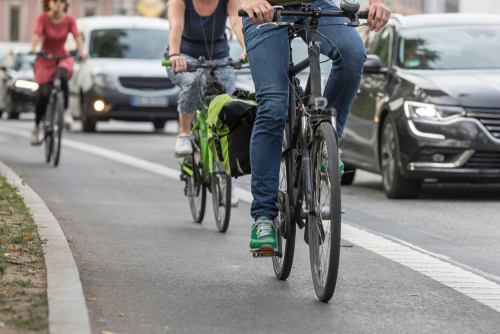
Changing infrastructure like curbs and sidewalks from liabilities into assets that improve mobility means using data to drive decisions on how communities can use them effectively and efficiently, one expert says.
Stephen Goldsmith, the Derek Bok Professor of the Practice of Urban Policy and the Director of the Innovations in American Government Program at Harvard’s Kennedy School of Government, said during a recent webinar hosted by the Eno Center for Transportation that moving to digital platforms that accumulate data can help cities determine how best to accomplish everything from the placement of meters to curbside parking to multi-modal usage.
Goldsmith said when he was mayor of Indianapolis and deputy mayor of New York, sidewalks and curbs were liabilities, “the things people tripped over and sue you for.”
But now, sidewalks and curbs are homes to not only foot traffic and car parking, but for temporary parking for delivery vehicles, and as drop off and pick-up locations for scooters. Post-COVID curbs and sidewalks bring up other issues about environmental concerns and public health concerns, at a time with city revenues are falling, and city officials are grappling with fair pricing solutions and equity in access, he said.
“As we look at these issues, if I’m a public official, what I’m thinking is that what is it that I’m trying to accomplish when it comes to curbs and sidewalks,” he said.
By moving to app-based payment platforms, he said, cities can implement contactless government, while increasing revenues.
In Austin, he said, mobility services supervisor Joseph Al-Hajeri chose to eliminate single-space meters. The result, Goldsmith said, was an increase in revenue and a reduction in expenses related to maintenance and a decrease in contagious contacts. According to Goldsmith, mobile payments tend to be 25-100 percent higher than those made at the meter, and larger cities can see as much as $1 million in revenue for every 10 percent increase in app utilization.
Using data derived from the apps, Goldsmith said, can help planners to determine better pricing structures.
Digital platforms also allow cities to “nudge behavior” through pricing, or quickly adjust pricing for event parking, lowering pricing where there are more spaces than demand, or even repricing spaces on the fly to better accommodate different communities, such as nurses trying to go to work.
But importantly, at the center of the curb and sidewalk management systems, however, needs to be a focus on the customer.
“We should have a system where that customer of the city can use any method of payment so that it pushes up revenue and pushes down inconvenience and adoption goes up,” he said.
The process though would require cities to have a digital inventory of curbs, sidewalks, parking spots, signs, and parking rules to be able to form a digital asset management system.
Having data flow through the asset management system can help city planners shift the locations of Uber/Lyft pick-up and drop-offs to more convenient and less busy street locations. It could also help cities with digital neighborhood parking permits, eliminating the need for consumers to make multiple trips to branch offices for multiple permits, but allowing law enforcement to monitor the permits through license plate recognition software, instead of officers.
By using data through the systems, Goldsmith said, cities can also use pricing structures to control behavior, such as where scooters are dropped off.
“Another way to address equity is to look at the scooter issue,” he said. “We should price the regulation of scooters so that we induce the drop off of scooters in places that don’t block sidewalks and don’t create hazards on those sidewalks.”
The ability to price the commercial loading zone is quite important, not just from the issue of revenue, but also of managing the clutter and safety around the curb and sidewalk.
Goldsmith said city planners also need to consider equity when addressing curbs and sidewalks. One issue, he said, was coming up with solutions that would allow the unbanked consumer to access the same digital and contactless services that banked consumers would have access to.
And by using a digital platform, he said, city planners could implement dynamic pricing that takes advantage of parking spot places in higher rent districts.
“We have to ask ourselves the following question: if we don’t use dynamic pricing and if we underprice the cost of parking in a commercially high-value area… then the city is basically saying we’re going to subsidize people parking there,” he said.
Instead, he said, dynamic pricing would allow cities to raise street parking pricing, which could, in turn, subsidize transit in other areas of the city that need it.